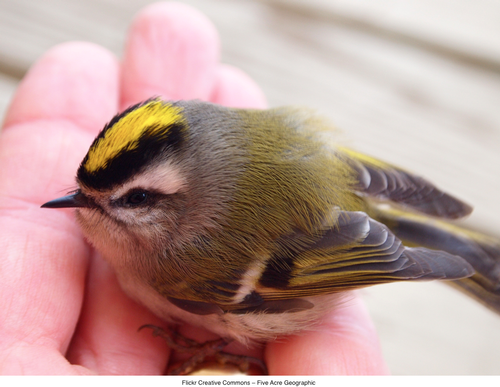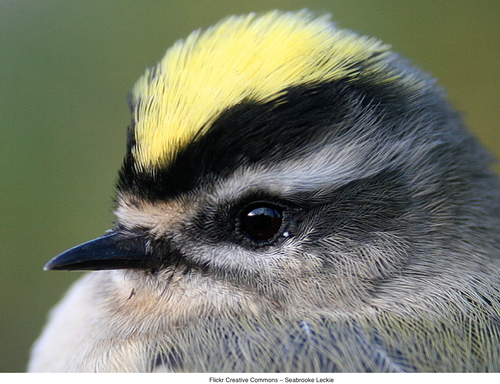Mystery of the Golden-Crowned Kinglet
The golden-crowned kinglet (Regulus satrapa) is the world’s smallest perching bird, weighing in at 5 grams, or the equivalent of two pennies. Kinglets are named “Regulus,” meaning “little king,” because of their bright yellow, orange, and red crowns. Despite its unbelievably small size, the bird somehow manages to survive Adirondack winters. When it comes to surviving winter temperatures overnight, kinglets have to become perfectionists. They must balance conflicting costs and benefits because they have such a small margin for error.
For a while, and even still today, it has been somewhat of a mystery how the kinglet is able to withstand winter conditions with such a small body. To be clear, this species suffers significant mortality every winter, and a severe enough storm could wipe out an entire local population. About 87% of the population perishes every year, but their extremely high reproductive success accounts for much of the recovery. Some even choose to migrate thousands of miles to warmer climes, but their weak flying abilities and small energy reserves cause about the same amount of mortality. It’s an astonishing feat that they have adapted their lives to survive at all during winter.
Preparing for Winter
The kinglet makes surprisingly few preparations for the winter. The most significant preparation is its nesting behavior. The kinglet’s nesting behavior is uniquely adapted to prepare for winter conditions. First, and rather morbid to be frank, the kinglet produces many offspring to compensate for a high winter mortality. But the kinglet’s nest preparations are designed more to protect their offspring from inclement weather than to compensate for anticipated loss.
Female kinglets begin building in mid-April by finding a spruce branch under which they suspend their nest. The positioning under a branch shields any view of the nest from above, provides coverage by a thick latticework of twigs and needles, and the branch itself serves as a physical barrier preventing any snow from filling up the nest. The nest is an elaborate construction process that involves suspending strands of spiderwebs, bark strips, and caterpillar silk into a hammock-like configuration within twigs of a spruce or fir tree. Moss, lichens, and strips of paper birch bark are then incorporated into the bottom and wall of the nest to give more structural support and shape to the nest, forming what could be described as a silken cocoon. The walls are insulated with hare fur and thousands of small bird feathers. The nest takes about 4-6 days to build.
Although the nests are designed to withstand any lingering winter effects into the month of April, they are not built for shelter in the following winter. Kinglets have some impressive foraging behavior that makes it difficult for them to have a permanent home.

Foraging Behavior
The kinglet has a diet of insects. Its tiny bill isn’t suitable for eating seeds or tree buds, but rather small insects. But it’s a mystery how the kinglet can manage to eat enough insects per day to keep high energy stores, let alone find insects that are still around in the winter. The kinglet actually eats 3 times its body weight in insects each day.
The answer to the first question lies in its high-octane foraging style. Kinglets are unbelievably active creatures. During the daytime in the winter, they never stop moving or foraging for more than 2 seconds at a time. This has become a necessary adaptation - the kinglet needs to be constantly eating so that it will have enough energy to keep warm during the cold winter months. If kinglets are without food for one or two hours in the daytime, they will starve and freeze to death. That’s why the golden-crown is constantly foraging - constantly hopping along twigs searching for insects.
What kinglets feed on has been a mystery for a long time, as it appears that they pick at invisible prey while foraging. They actually just feed on tiny geometrid (“inch-worm”) caterpillars of the species Hypagyrtis unipunctata that typically live on spruce or fir trees. The caterpillars freeze in the winter and are still able to revive in the spring - a fascinating adaptation in itself if they manage to escape the predation of the golden-crowned kinglet.
Body Temperature Regulation
 During the day in winter, kinglets need to keep a high body temperature and high rate of metabolism to combat the cold. At temperatures as low as -22ºF, kinglets maintain a body temperature near 111ºF (5º higher than that of most birds and 12º higher than that of a healthy human). Their inch-thick layer of feathers provides impresive insulation. About 80% of a kinglet’s feather mass is committed to insulation, with the remainder to flight.
During the day in winter, kinglets need to keep a high body temperature and high rate of metabolism to combat the cold. At temperatures as low as -22ºF, kinglets maintain a body temperature near 111ºF (5º higher than that of most birds and 12º higher than that of a healthy human). Their inch-thick layer of feathers provides impresive insulation. About 80% of a kinglet’s feather mass is committed to insulation, with the remainder to flight.
An active kinglet must also expend at least 13 calories per minute to stay warm at -29ºF. Like chickadees, kinglets increase their fat stores during the day. One study showed they went from 0.25 grams at 8 AM to 0.60 grams at 5 PM, which is about twice as much fat relative to body size as the chickadee.
Night time for kinglets is a different battle. Kinglets would seem to be stuck in a quandary at night where they must shut their body’s resources down to some degree to have any energy left, but they also have to keep active because a few moments without shivering would freeze them to death. It’s predicted that kinglets can’t let their body temperature dip below 50ºF or else they’ll lose their ability to shiver and succumb to quite literally freezing. Although no one has been able to prove it, given all the calculations of energy reserves and energy demands, it seems almost inevitable that kinglets go hypothermic. Winter nights are consistently -22ºF in the Adirondacks. Kinglets simply don’t have enough calories in fat to keep their body temperature at 111ºF.
When sleeping, kinglets reduce heat loss through their eyes and bills by tucking their heads into their feathers. However, they also can potentially lose body heat through their feet. Kinglets reconcile this problem with a countercurrent heat exchange and/or reduction in blood flow to the legs, keeping leg and foot temperatures as low as possible. Interestingly, kinglets can reverse the blood flow to have the opposite effect of sending heat towards their feet. Female kinglets use this heat supply to incubate their eggs.
Overnight Shelter
Like most other aspects of a kinglet’s life, very little is known about where kinglets find shelter overnight. It’s believed that they will do anything to forage until daybreak or use a variety of nearby shelters.
Kinglets are almost always in groups of two to five individuals. Though small in size, their group cohesion is impressive. Sticking with others helps with foraging, finding nesting sites, and most importantly, huddling together at night for additional insulation. Communication is key for kinglets to stay with their group, and in turn, find a warm sleeping place for the night. Kinglets are in constant vocal contact throughout the day so that they don’t separate from their group in the dense woods. Unlike their foraging style, kinglets don’t leave their source of warmth at night up to chance. While foraging, kinglets make special calls when they’ve found a potential sleeping place. A second call is made as the last bit of daylight fades for the group to cluster together. The birds huddle in a group and those at the center tuck their heads below their shoulders with their bills pointing up. Those on the outside of the cluster tuck their heads back and to one side under their wing feathers. Time is always of the essence for golden-crowned kinglets, so they minimize the time that they huddle usually to 5 minutes when its cold, and sometimes to just seconds if they are with family members.

